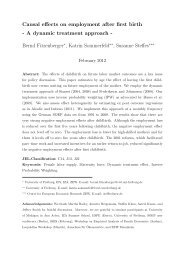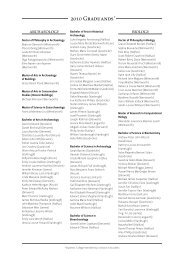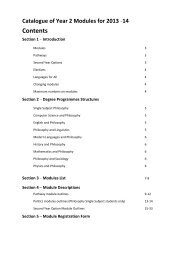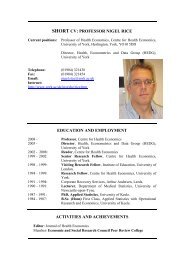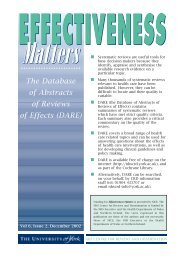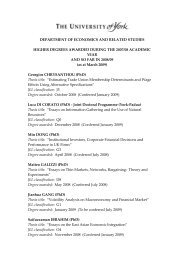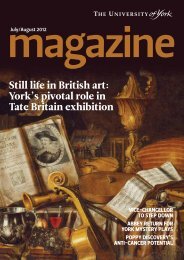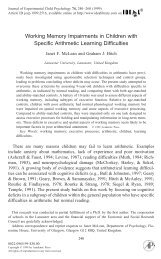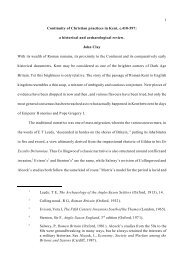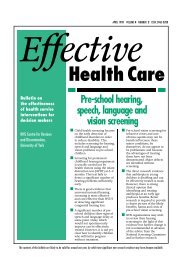GeloriniPhD (PDF , 6973kb) - University of York
GeloriniPhD (PDF , 6973kb) - University of York
GeloriniPhD (PDF , 6973kb) - University of York
You also want an ePaper? Increase the reach of your titles
YUMPU automatically turns print PDFs into web optimized ePapers that Google loves.
Type HdV-1020 (Plate II)<br />
. 51 .<br />
CHAPTER 1<br />
Diversity and ecology <strong>of</strong> tropical African fungal spores<br />
Fungal spore ellipsoidal, 24-28 x 16-18 µm. Apices have thicker walls, darker than central part. Rare in the Challa record<br />
(9 specimens), and except for a single find dated to ca. AD 1900, occur only in Glacial and Late-Glacial sections before<br />
13,800 cal. yr BP.<br />
Type HdV-1022: Clasterosporium sp. (Plate II)<br />
Conidia obclavate, transversally septate, ca. 53 x 12 µm. Dark cells showing striae. Identification is based on Ellis (1971).<br />
Rare in the Challa record (3 specimens).<br />
Type HdV-1023: Spegazzinia intermedia M.B. Ellis (Plate II)<br />
Conidia disc-shaped, flattened, dentate at the margin, cruciately septate, ca. 28 µm in diameter. This fungus has been<br />
isolated from soil and from Hibiscus in Tanzania and from tobacco in the USA (Ellis, 1976). Jarzen and Elsik (1986)<br />
described and illustrated Spegazzinia-like spores from river deposits in Zambia. These conidia are rare in the Challa<br />
record (9 specimens), being restricted to Holocene and Late-Glacial sediments younger than 14,700 cal. yr BP.<br />
Type HdV-1024: Brachysporium cf. pulchrum M.B. Ellis (Plate II)<br />
Conidia mostly 4-septate, 41-50 x 20-25 µm, central cell very large, dark brown, other cells pale and smaller. B. pulchrum<br />
has been found on Phylica (Rhamnaceae) on Tristan da Cunha (Ellis, 1971). This type should not be confused with Type<br />
UG-1099 (Gelorini et al., 2011), which as suggested by size differences includes several other Brachysporium species apart<br />
from B. pulchrum. Rare in the Challa record (11 specimens), mainly recovered from mid- and late Holocene sediments.<br />
Type HdV-1025: Diplocladiella cf. scalaroides G. Arnaud ex M.B. Ellis (Plate II)<br />
Conidia triangular, 2-horned, ca. 25 µm wide from horn tip to horn tip, horns 2-septate. The species was observed on<br />
dead wood in Europe (Ellis, 1976). Fossil spores were recorded by Barthelmes et al. (2006) in a Holocene deposit in<br />
Germany. Rare in the Challa record (8 specimens), with sporadic distribution.<br />
Type HdV-1026: Peziza/Scutellinia (Plate II; Fig. 1.2)<br />
Ascospores elliptical but slightly asymmetrical, ca. 23 x 9 µm, covered with fine warts. Spores <strong>of</strong> this type are common<br />
throughout the Challa record, and particularly abundant in the early Holocene section.<br />
Type HdV-1027: Munkovalsaria donacina (Niessl) Aptroot (Plate II; Fig. 1.2)<br />
Ascospores ca. 19 × 7 µm, elliptical, thick-walled, 1-septate near in the middle, constricted at septum, one cell wider and<br />
pointed, the other cell longer and rounded (Aptroot, 1995). This species has been found on a variety <strong>of</strong> plants. In the<br />
Challa record it is most common in the full Glacial period (20,500-18,500 cal. yr BP) and the mid-Holocene (7000-4000<br />
cal. yr BP), but also recorded in other periods.



